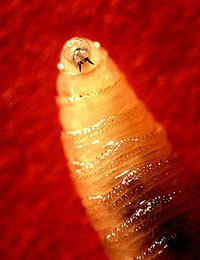
Among other innovative and proactive solutions, Sec. Rollins committed federal funding to construct a sterile fly production facility in Edinburg, Texas. The establishment of sterile fly production capabilities in Texas is pivotal to combatting the pest if it crosses the Texas border and crucial for a comprehensive eradication approach. Combined with robust science-based response efforts, the sterile insect technique is the proven eradication method needed to reduce the impacts of a NWS incursion.
“The TAHC commends Sec. Rollins and Gov. Abbott’s critical action in expanding New World screwworm eradication efforts,” said Dr. Bud Dinges. “Today’s announcement bolsters the ongoing collaborative efforts between the USDA and Texas animal health officials to serve as the first line of defense in protecting U.S. animal agriculture.”
The Texas Animal Health Commission continues to work with state and federal partners, including USDA Animal and Plant Health Inspection Service (APHIS), to approach NWS response planning and actions with a commitment to promote overall animal health and productivity and reduce potential impacts to the industry. Building upon Sec. Rollins five-pronged plan issued in June, the following immediate actions, announced today enact additional approaches in combatting NWS.
- Innovate our Way to Eradication- USDA will support scaling and implementing proven concepts as well as a number of longer-term research projects focused on: new sterile NWS production techniques, novel NWS traps and lures, NWS therapeutics that could be stockpiled and used should NWS reach the U.S., and any other tools to bolster preparedness or response to NWS.
- Protect the United States Border- USDA will construct a domestic sterile New World screwworm production facility in Edinburgh, TX, capable of producing 300 million sterile flies per week.
- Wildlife Migration Prevention- Tick riders and detector dog capabilities are being enhanced to focus on border surveillance to provide the first line of defense against a NWS outbreak along the U.S./Mexico border.
- Stop the Pest from Spreading in Mexico and Ensure We are Full Partners in Eradication- Federal officials commit to continue working with Mexico to contain the pest south of the U.S. border. Successful implementation will inform any future trade decisions impacting cattle movements on the southern border including the potential reopening of border areas.
- United States Food Safety is of Utmost Importance- USDA Food Safety and Inspection Service (FSIS) remains committed to inspecting animals and carcasses to keep the food supply safe and secure.
While NWS has not been detected in Texas or the U.S., due to Texas’ vast border with Mexico, the risk of a NWS incursion in Texas is of ongoing concern. Consistent collaboration between government and industry groups continues to amplify preparedness in Texas and support the capabilities of early detection and quick response.
“Texas is in preparedness mode, not panic mode, and the announced commitments are an incredibly impactful and necessary piece to that preparedness,” said Dr. T.R. Lansford. “Producers play a huge role in preparing their own operations to combat the pest and preventing potential spread by conducting their own surveillance, reporting suspicions, and adopting management practices that will reduce NWS infestations.”
Read the latest USDA’s information on NWS here. Read the Office of the Governor’s press release here. Learn more about NWS here.


